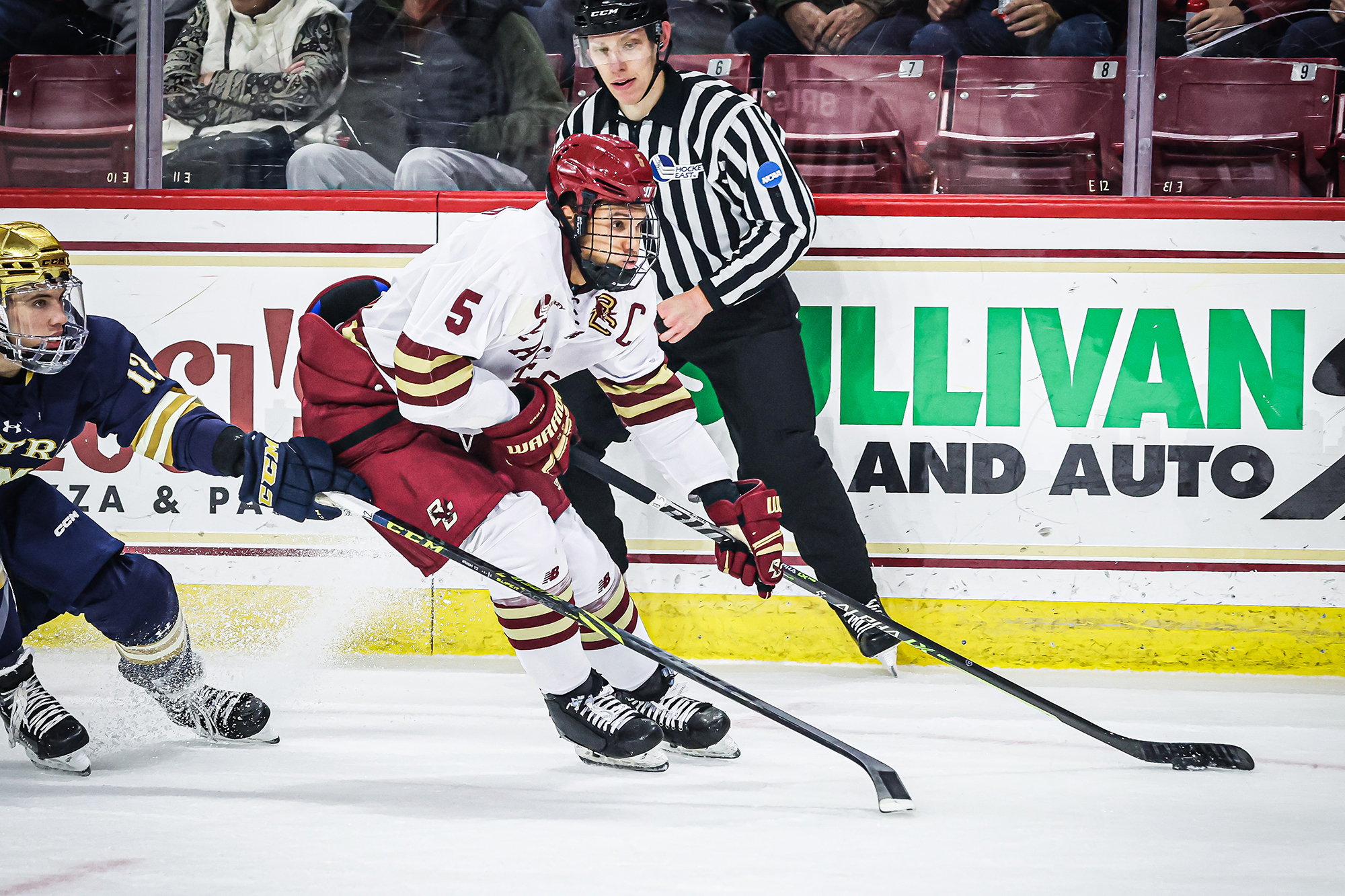
Hockey Hello: Marshall Warren

Editor’s Note: This piece is written by Peter South, a college hockey scout who MGoBlog has added to the crew for occasional hockey pieces- starting with Hello posts for the transfers that the hockey team has picked up.
Looking to fill the big shoes that were left by Luke Hughes, who signed his Entry Level Contract with the New Jersey Devils after the Wolverines’ 2022-23 season came to an end at the Frozen Four in Tampa, Michigan picked up grad transfer Marshall Warren from Boston College. Warren brings an element that that has been missing from the Michigan lineup since the graduation of Nick Blankenburg, a veteran blueliner who can play heavy minutes, contribute on the powerplay, and be a leader in the defensive zone as well as the locker room. Entering this upcoming season, Warren has played 130 NCAA games- 41 more than Jacob Truscott. He's also a graduate of the USNTDP in Plymouth, where he participated in high-level international competition playing alongside former Wolverines Cam York, John Beecher, and Matty Berniers and current NHL stars Jack Hughes, Cole Caufield, and Trevor Zegras.
We’re going to dive into what Marshall Warren brings to the Maize and Blue by comparing his metrics against those of Michigan’s starting defensive lineup from last season (going forward they will be noted as the D-Core). For the purpose of this piece, we’re going to define the “starting defensive lineup” from last season as Luke Hughes/Jacob Truscott, Seamus Casey/Ethan Edwards, and Keaton Pehrson and Jay Keranen. The statistics for this piece are drawn from HudlInstat, the go-to for teams and leagues world-wide. One final note: to bring some balance to the numbers, they are all based on 60 minutes of playing time as opposed to just games.
[After THE JUMP: Surprise, he isn’t Luke Hughes... but he's still good]

[BC Athletics]
Ice Time
The average amount of ice time each of the Michigan D-Core logged last season was 20:21 per player. Luke Hughes averaged the most time at 25:28 per 60 minutes. When averaging the whole D-Core, they averaged 20:21 per 60 minutes, along with an average of 2:04 on the powerplay and an average of 2:36 on the penalty kill. Warren logged an average of 23:46 per 60 minutes at Boston College, a heavy workload overall. He also logged 1:59 on the PP and 2:38 on the PK, playing a sizable role on special teams. Warren’s overall ice time was 2nd most for defensemen at BC and his PP and PK time were 3rd and 1st, respectively, among BC blueliners. Next, we should take a peek at the distribution of zone-time within those minutes. The Wolverine D-Core spent an average of 26:30 in the offensive zone and 24:39 in their defensive zone. By comparison, Marshall Warren averaged 25:38 in the offensive zone and an almost identical 25:53 in the defensive zone per 60 minutes.
Ice Time per 60 Min
|
Avg. Ice Time |
Power Play Time |
Short Handed Time |
Offensive Zone Time |
Defensive Zone Time |
|
|---|---|---|---|---|---|
|
Michigan D-Core |
20:21 |
2.04 |
2:36 |
26:30 |
24:39 |
|
Marshall Warren |
23:46 |
1:59 |
2:38 |
25:38 |
25:53 |
Puck Retrievals
Retrieving the puck after shots and dump-ins, and winning board battles to do so, are crucial to a team being able to counter and move the puck down ice to generate offence. Warren's average puck retrievals after shots was below the average of the Wolverines D-Core from last year, as they averaged 6.205 per 60 minutes compared to Warren's 5.19. There are likely a number of factors contributing to this, such as Warren being positioned more around the net and the Michigan figure being positively skewed by Seamus Casey averaging 7.92 retrievals per 60 minutes on his own. On opponent’s dump-in retrievals, Warren recorded a 5.73 average per 60 minutes compared to the Wolverines D-Core averaging 3.895 per 60 minutes (Seamus Casey again leading the way with 4.13). Loose puck recovery, which comes from having great anticipation and the ability to read and react to the situation, is an area Warren stands out from Michigan’s existing defense. He averaged 13.2 recoveries per 60 minutes, while the U of M D-Core averaged 10.53 as a group. (Ethan Edwards led the group with a 14.6 average).
Puck Retrievals per 60 Min
|
P.R. after Shot |
Opp. Dump-In Retrieval |
Loose Puck Recovery |
|
|---|---|---|---|
|
Michigan D-Core |
6.205 |
3.895 |
10.53 |
|
Marshall Warren |
5.19 |
5.73 |
13.2 |

[BC Athletics]
Board Battles/Takeaways
Board battles in the defensive zone are critical for defensemen, as losing one can lead to a high danger scoring chance for the opposition. As a collective, the U of M D-Core won 17.01 battles per 60 minutes whereas Marshall Warren won 18.4 per 60 min, a point in favor of the transfer. Takeaways through body checks and stick checks in both the defensive and neutral zones are also important numbers to look at as they generally lead to good transition opportunities. Warren averaged 15.8 of these in the defensive zone and 4.84 in the neutral zone per 60 minutes, compared to the Wolverines D-Core which averaged 15.41 in the defensive zone and 3.44 in the neutral zone. In this phase of the game, the addition of Warren will boost Michigan’s defensive group, as his NZ number reflects his experience, excellent gap control, and quickness on his feet.
Board Battles per 60 Min
|
Board Battles |
Takeaways – DZ |
Takeaways – NZ |
|
|---|---|---|---|
|
Michigan D-Core |
17.01 |
15.41 |
3.44 |
|
Marshall Warren |
18.4 |
15.8 |
4.84 |
Defensive Zone Exits
Another important aspect to look at with defensemen are defensive zone exits. First, we'll look at the Wolverines D-Core per 60 minutes. They averaged 14.26 breakouts per 60, of which 8.46 came via a pass, 0.152 via a dump out (either off the glass or a high flip), and 5.69 by skating the puck out of the zone. This final stat is juiced by Luke Hughes, who skated the puck out of the zone a staggering 11.8 times per 60 minutes, miles ahead of the next highest defender Seamus Casey, who averaged 6.95. Marshall Warren, per 60 minutes, averaged 15.8 breakouts, higher than the Michigan average on the whole but different in method. Warren broke the puck out via the pass (10.3) and via the dump out (0.41) more often than Michigan’s defense, while his 5.05 breakouts via skating the puck out of the zone was lower than Michigan’s Hughes-infused number. A multitude of factors can be attributed to the different ways a defender gets the puck out of the zone, but the most important thing is that overall number, where Warren exceeded the Wolverines average by more than 1.5 exits per 60 minutes. He will be an asset to the Michigan team breaking the puck out of the zone.
Defensive Zone Exits per 60 Min
|
D-Zone Exits |
Exits via Pass |
Exits via Dump |
Exits via Skate |
|
|---|---|---|---|---|
|
Michigan D-Core |
14.26 |
8.46 |
0.152 |
5.69 |
|
Marshall Warren |
15.8 |
10.3 |
0.41 |
5.05 |

[BC Athletics]
Zone Entries
Entering the offensive zone is usually structured by the coaching staff. If the entry looks to be a potential odd-man situation, then carrying the puck is the norm. If it’s a 3 on 3 or 4 on 4 situation, depending on the team’s philosophy a team will either attack wide, down the middle or opt to dump the puck in and try and regain possession on the forecheck (usually for less-skilled teams). When the entry is being led by a defenseman, his decision is an important action on the ice, as a turnover at the blue line can lead to an odd-man rush for the opposition. Zone entries are broken down by overall entries, entries via passing, entries via dump-in and controlled entries (skating the puck in).
The Wolverines D-Core averaged 9.71 zone entries per 60 minutes last season, unsurprisingly led by Luke Hughes with 18.1 and Seamus Casey with 15.3. Once you get past those two, the numbers drop off significantly. Marshall Warren averaged 9.55 zone entries per 60 minutes, a hair below the team average. The Michigan D-Core average for zone entries via passing was 4.11, entries via dump-ins were 1.045 and entries via controlled entry were 1.36. Warren's Zone Entries were broken down as follows: 4.23 via Passing (slightly higher), 0.82 were via Dump-In (lower) and 4.5 were by controlled entry (much higher). That latter number would seem to be the most notable takeaway from this point.
Zone Entries per 60 Min
|
Overall Entries |
Via Pass |
Via Dump-In |
Via Control |
|
|---|---|---|---|---|
|
Michigan D-Core |
9.71 |
4.11 |
1.045 |
1.36 |
|
Marshall Warren |
9.55 |
4.23 |
0.82 |
4.5 |
Shots
Shots from the point have been a major component of hockey since the advent of the slapshot and it still is today. With defensive players more willing than ever (and having better equipment) to block shots, the ability to get a shot through from the point is vital to a team's offensive success. Today’s best offensive defensemen are deceptive with the puck and utilize quick feet to find an open lane. We’re going to look at shot attempts, shots on goal, and shots that were blocked to break down Warren’s abilities as a shooter. The Wolverines D-Core averaged 11.608 shots per 60 minutes, of which 5.53 got through to the net and 3.15 were blocked. Marshall Warren averaged 12 shots per 60 minutes, a bit higher than Michigan’s number. He had an average of 5.9 shots make it to the net and 2.9 were blocked per 60 minutes, a bit more effective at getting shots through to the target than the average Michigan defender last year.
One part of our great game that has changed over the past couple of decades is a team’s philosophy on the power play, and this is notable when looking at a defenseman. The slapshot from the point, which was once commonplace in years past, has now been replaced by the bumper play down low or the backdoor pass through the seam, limiting defensemen shots on the man-advantage. Michigan's D-Corp on the powerplay registered an average of 2.346 shots, more shot-prone than Warren, who played primarily on the 2nd PP unit at Boston College and averaged 1.5 shots per 60 minutes.
Shots per 60 Min
|
Shot Attempts |
Shots on Goal |
Blocked Shots |
P.P. Shots |
|
|---|---|---|---|---|
|
Michigan D-Core |
11.608 |
5.53 |
3.15 |
2.346 |
|
Marshall Warren |
12 |
5.9 |
2.9 |
1.5 |

[Hockey East]
Scoring
Putting up points from the backend is a huge boost to any team's offence and Michigan’s 2022-23 defense excelled at this, with three members (Hughes, Casey, and Truscott) averaging more than 2 points per 60 minutes. They did more than their part to drive the offence. For this point we’re going to breakdown where the points came from and how they compare to Marshall Warren. Michigan’s D-Core averaged 0.406 goals per 60 min last season, while Warren scored 0.34 goals for BC. A point in favor of Michigan. As for assists, you have to break them into 1st assists (Primary) and 2nd assists (secondary), as primary assists have historically been far more significant, while secondary assists are much more random. The Michigan blueliners averaged 1.245 assists per 60 minutes, with 0.6416 being primary assists and 0.605 being secondary assists. Marshall Warren averaged 0.61 assists per 60 minutes last season, with 0.27 being the primary assists and 0.34 being the secondary assists, so a lower output overall and tilted a bit more towards secondary assists. However, Warren’s reduced point totals are to some degree a function of the team he played on; Boston College averaged 2.89 goals per game, while Michigan averaged 4.17.
Scoring per 60 min
|
Goals |
Total Assists |
Primary Assist |
Secondary Assist |
|
|---|---|---|---|---|
|
Michigan D-Core |
0.406 |
1.245 |
0.6416 |
0.605 |
|
Marshall Warren |
0.34 |
0.61 |
0.27 |
0.34 |
Advanced Analytics
Shooting statistics wouldn't be complete if we didn't look at the advanced analytics, possession metrics Corsi and Fenwick, as well as expected goals (xG). The Michigan D-Core had a 2.22 Corsi average for 60 min and a 51.3% Corsi For percentage. Warren had a 4.98 Corsi average for 60 min and 52.9% Corsi For percentage. Fenwick is a similar possession metric to Corsi, but it excludes blocked shots. The Wolverine defenders average in the Fenwick For% was 53.6% per 60 min and Marshall Warren had a Fenwick For% of 53.1% for 60 min, a bit lower for Warren but not dramatically, especially when accounting for the caliber of team he was on. Expected Goals (xG) takes into account the quality of shot and uses league-wide averages to determine the likelihood of that shot being a goal. The Wolverine D-Core had an average xG (Expected Goals) of 0.4 and an average Team xG when on ice of 2.99 and a 3.44 Opponents xG when on ice for 60 min. Marshall had a 0.34 xG and a 2.52 Team xG when on ice and a 3.34 xG Opponents xG when on ice for 60 minutes. Given his heavy usage on the PK and the team he was on, this was about in line with expectations.
Advanced Analytics per 60 Min
|
Corsi |
Corsi for, % |
Fenwick for, % |
xG |
Team xG when on ice |
Opp. xG when on ice |
|
|---|---|---|---|---|---|---|
|
Michigan D-Core |
2.22 |
51.3% |
53.6% |
0.4 |
2.99 |
3.44 |
|
Marshall Warren |
4.98 |
52.9% |
53.1% |
0.34 |
2.52 |
3.34 |

[BC Athletics]
Final Word
After analyzing the critical data comparing Michigan’s defensive from last season to Marshall Warren at Boston College, it is clear that Warren will fit in nicely for the Wolverines. It's no secret that Michigan losing Luke Hughes from their defensive unit has left a big void that isn't easy to fill and while Warren certainly can’t replace what Hughes gave the team in the way of skating the puck out of the zone or point-production, he is a heavy workload defenseman who will eat minutes that Hughes once played. And crucially, he potentially adds an improvement in various areas, winning board battles, recovering dump-ins, entering the zone with control, and getting shots through on net.
Warren brings in a wealth of experience, has the elite skating ability that is a must with the Wolverines, and has proven to be a player who can be leaned on to play big minutes and can contribute both defensively and offensively. He also boasts intangibles that can’t be measured from the many years he’s spent in the NCAA previously. Warren figures to be a leader within the locker room and should mentor some of the younger players, including sophomore defenseman Tyler Duke, who transferred in from Ohio. All in all, Warren is a solid pickup for the Wolverines. He should play on their PK and PP2, projects to strengthen the defense in areas that were lacking last season and makes the locker room stronger. He may not be Luke Hughes, but he is a legit NCAA defenseman and that’s why snaring his services was an offseason win for Brandon Naurato.
Since you are Canadian, any relationship to Peter North?
Don't you mean Hello: Warren Bennet?
Yeah, but is he going to redshirt?
Outstanding! Welcome to the site
Great stuff! Thanks for the in-depth analysis. Looking forward to more.
One question about the numbers in the section "Zone Entries per 60 Min". The component numbers (pass, dump-in, control) for Warren add up to his total overall entries. However, the component numbers for the Michigan D-core add up to significantly less than their total overall entries. What am I missing with how those numbers were compiled?
Great write up!! Love the hockey content
Great stuff! Do you know if Warren was regularly utilized or excels playing as the right D? Michigan only has two right shot D (Casey, Holtz) that will likely slot in the top 6, so excelling while playing on his offside would be an asset. With this in mind, how do you see the pairings shaping up?
Truscott (L) Casey (R)
Warren (L) Edwards (L)
Duke (L) Holtz (R)
Fantilli (L), Druskinis (R) Orrico (R)
Welcome to MGoInsanity. Nice intro post, you have set the bar high. Keep that hockey content coming.
Moar Hockey! Even if it has to come from that guy down South.
Marshall sounds like the deal.
I like beauty, and gets it done on the boards is beautiful.
Now I just need one subscription to take in all Michigan hockey that I can slip under the monthly subscription rug. It helped to have my wife go to a game last year. She is now a hockey fan!
Let's get Jim Harbaugh on the ice while he's iced.
Let do it. A new no fly zone is taking shape post Hughes.
Let's go Blue!
Comments